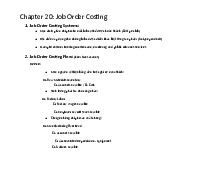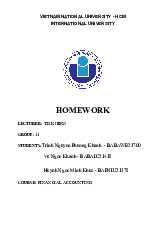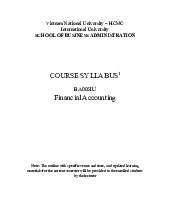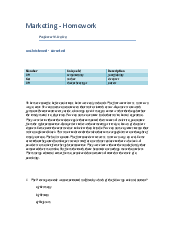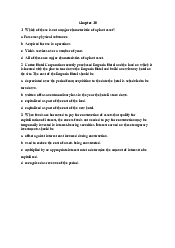


Preview text:
EXERCISE SET 1
Exercise 1: J. F. Outz, M.D., has been practicing as a cardiologist for three years. During
April 2009, Outz completed the following transactions in her practice of cardiology: Apr.
1. Paid office rent for April, $800.
3. Purchased equipment on account, $2,100.
5. Received cash on account from patients, $3,150.
8. Purchased X-ray film and other supplies on account, $245.
9. One of the items of equipment purchased on April 3 was defective. It was
returned with the permission of the supplier, who agreed to reduce the account for
the amount charged for the item, $325.
12. Paid cash to creditors on account, $1,250.
17. Paid cash for renewal of a six-month property insurance policy, $370.
20. Discovered that the balances of the cash account and the accounts payable
account as of April 1 were overstated by $200. A payment of that amount to a
creditor in March had not been recorded. Journalize the $200 payment as of April 20.
24. Paid cash for laboratory analysis, $545.
27. Paid cash from business bank account for personal and family expenses, $1,250.
30. Recorded the cash received in payment of services (on a cash basis) to patients during April, $1,720.
30. Paid salaries of receptionist and nurses, $1,725.
30. Paid various utility expenses, $360.
30. Recorded fees charged to patients on account for services performed in April, $5,145.
30. Paid miscellaneous expenses, $132.
Outz’s account titles, numbers, and balances as of April 1 (all normal balances) are listed
as follows: Cash, 11, $4,123; Accounts Receivable, 12, $6,725; Supplies, 13, $290;
Prepaid Insurance, 14, $465; Equipment, 18, $19,745; Accounts Payable, 22, $765; J. F.
Outz, Capital, 31, $30,583; J. F. Outz, Drawing, 32; Professional Fees, 41; Salary
Expense, 51; Rent Expense, 53; Laboratory Expense, 55; Utilities Expense, 56; Miscellaneous Expense, 59. Requirements:
1. Journalize each transaction in a two-column journal.
2. Post the journal to the ledger, extending the month-end balances to the appropriate
balance columns after each posting.
3. Prepare an unadjusted trial balance as of April 30.
Exercise 2: Derby Co. has the following accounts in its ledger: Cash; Accounts
Receivable; Supplies; Office Equipment; Accounts Payable; Terri Burell, Capital; Terri
Burell, Drawing; Fees Earned; Rent Expense; Advertising Expense; Utilities Expense; Miscellaneous Expense. 1
Journalize the following selected transactions for March 2009 in a two-column journal.
Journal entry explanations may be omitted.
Mar. 1. Paid rent for the month, $3,000
2. Paid advertising expense, $1,800
5. Paid cash for supplies, $900
6. Purchased office equipment on account, $12,300
10. Received cash from customers on account, $4,100
15. Paid creditor on account, $1,200
27. Paid cash for repairs to office equipment, $500
30. Paid telephone bill for the month, $180
31. Fees earned and billed to customers for the month, $26,800
31. Paid electricity bill for the month, $315
31. Withdrew cash for personal use, $2,000 Exer
cise 3: Travis Fortney, an architect, opened an office on April 1, 2010. During the
month, he completed the following transactions connected with his professional practice:
a. Transferred cash from a personal bank account to an account to be used for the business, $30,000.
b. Purchased used automobile for$19,500, paying $4,500 cash and giving a note payable for the remainder.
c. Paid April rent for office and workroom, $3,000.
d. Paid cash for supplies, $1,450.
e. Purchased office and computer equipment on account, $6,000.
f. Paid cash for annual insurance policies on automobile and equipment, $2,000.
g. Received cash from a client for plans delivered, $7,500.
h. Paid cash to creditors on account, $1,750.
i. Paid cash for miscellaneous expenses, $500.
j. Received invoice for blueprint service, due in May, $1,000.
k. Recorded fee earned on plans delivered, payment to be received in May, $5,200.
l. Paid salary of assistant, $1,600.
m. Paid cash for miscellaneous expenses, $325.
n. Paid installment due on note payable, $250.
o. Paid gas, oil, and repairs on automobile for April, $400. Requirements:
1. Record the above transactions directly in the following T accounts, without
journalizing: Cash; Accounts Receivable; Supplies; Prepaid Insurance;
Automobiles; Equipment; Notes Payable; Accounts Payable; Travis Fortney,
Capital; Professional Fees; Rent Expense; Salary Expense; Blueprint Expense;
Automobile Expense; Miscellaneous Expense. To the left of each amount entered
in the accounts, place the appropriate letter to identify the transaction.
2. Determine account balances of the T accounts. Accounts containing a single entry
only (such as Prepaid Insurance) do not need a balance. 2 3.
Prepare an unadjusted trial balance for Travis Fortney, Architect, as of April 30, 2010. 3
